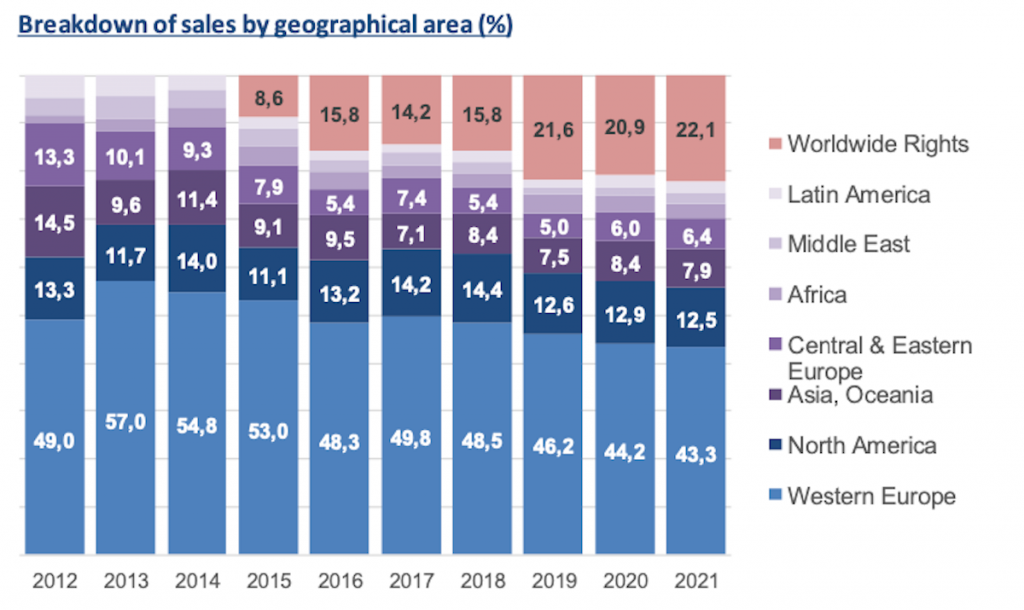
After more than 35 years of operation, TBI is closing its doors and our website will no longer be updated daily. Thank you for all of your support.
TBI Tech & Analysis: Unpacking how French content sales shifted in 2021
Unifrance’s annual report revealed a swathe of findings last week, not least that French TV exports hit a record €376m ($373m) in 2021. Richard Middleton delves into the full findings to explore what else we can learn.
France’s TV industry enjoyed a buoyant 2021, with international spending on French audiovisual programmes – namely sales, pre-sales and investment in coproduction – up 6% on 2020, according to figures from the National Centre for Cinema and the Moving Image (CNC) and Unifrance.
Spending on international TV projects in France, meanwhile, soared to €302.7m, up from €134.3m in 2020 and €97.9 in 2018, fuelled largely by improvements to the country’s Tax Rebate for International Production (TRIP). But where has all this spending come from and what sorts of buyers are in acquisitive mood?
Country breakdown
While France’s TV exports reached a new high of $376m last year, it wasn’t all good news. Straight sales actually dipped more than 5% in 2021 to €186.1m, but pre-sales soared more than 30% to hit €101.5m, helping the overall figure.
Of equal interest is just where all this buying has come from. As might be expected, Europe took the top spot with €80.6m, with Germany (€15.9m), the UK (€14.1m) and Italy (€12.1m) the top three importers.
The findings, which were published last week at Les Rendez-Vous Unifrance in Biarritz, showed that the US and Canada contributed €23.3m, while Asia came in third with €14.7m.
That was followed by buyers in Africa spending €6m on shows from the country, while Lat Am accounted for €4.2m worth.
On the genre front, drama continues to fuel the French content business, with ‘fiction’ accounting for more than 40% of European acquisitions – notable series such as StudioCanal’s Paris Police 1900 – which has sold to Sky Germany and SBS in Australia – and the Alliance’s La Jeune Fille et la Nuit were highlighted by Unifrance. Docs and animations stood around 20%, while format sales stood at 15%.
Over in North America, animation took the lead on the spending front with 36%, followed by fiction (30%) and docs at 15%. In Asia, animation spending was far ahead at 56% of spending, followed by docs (27%) and fiction (14%).
Streamers’ shares
While three European countries were the biggest importers of French TV shows, spending on global rights deals was still commensurate, even if the category remained relatively steady at €41.1m – or 22% – overall.
It’s worth rewinding a little here to explore how this figure has soared over the past seven years, from 8.6% in 2015. However, it has then been stable, standing at 22% in 2019 and 21% in 2020. Also worth noting how Western Europe sales have declined through this same period, from 53% in 2015, to 46% in 2019 and 44% in 2020.
And while services such as Netflix and Amazon Prime Video do account for the majority of worldwide deals – 53% belong to non-linear, such as SVOD,
AVOD and Free VoD – the proportion of worldwide rights deals not from the major streamers of the world may come as some surprise.
In terms of the deals themselves, animation accounted for 52.3% of total worldwide sales, with fiction and docs around 18% each, but it was the surging amount of AVOD deals that proved most noticeable.
AVOD sales stood at 18.3% of worldwide rights sales in 2021, compared with just 12.0% in 2020, underlining how quickly the market is shifting. Unifrance said that there had been a “declining trend” towards worldwide rights deals by SVOD’s, pointing to a “slowdown” in the market, especially in North America. The report also highlighted that there were “more complex discussions with platforms about holdbacks”, which can affect second window sales.




